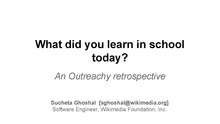Outreach

Outreach is an activity of providing services to any populations who might not otherwise have access to those services.[1][2] A key component of outreach is that the groups providing it are not stationary, but mobile; in other words they are meeting those in need of outreach services at the locations where those in need are.[1][2][3] In addition to delivering services, outreach has an educational role, raising the awareness of existing services.[3]
Outreach is often meant to fill in the gap in the services provided by mainstream (often, governmental) services, and is often carried out by non-profit, nongovernmental organizations.[1] This is a major element differentiating outreach from public relations.[4] Compared with staff providing traditional services, Dewson et al. (2006) notes that outreach staff may be less qualified, but are more highly motivated.[3]
Rhodes (1996) distinguishes between three types of outreach: domiciliary (undertaken at individual homes), detached (undertaken in public environments and targeting individuals), and peripatetic (undertaken at public or private environments and targeting organizations rather than individuals).[5] Dewson et al. (2006) lists another type in addition to those three: the satellite type, where services are provided at a dedicated site.[3]
Dewson et al. (2006) list the following tools of outreach: leaflets, newsletters, advertising; stalls and displays, and dedicated events, with the common location being local community institutions such as libraries, community centres, markets and so on.[3] Compared with traditional service providers, outreach services are provided closer to individuals residence, are voluntary, and have fewer, if any, enforceable obligations.[3]
Outreach can target various populations, from sex workers[1] and drug users,[5] to museum goers.[6]
See also
References
- 1 2 3 4 Kate Hardy; Sarah Kingston; Teela Sanders (16 December 2010). New Sociologies of Sex Work. Ashgate Publishing, Ltd. p. 77. ISBN 978-0-7546-7986-8. Retrieved 16 September 2012.
- 1 2 Legal Services Research Centre (30 March 2009). Reaching Further: Innovation, Access and Quality in Legal Services. The Stationery Office. pp. 73–74. ISBN 978-0-11-706724-0. Retrieved 17 September 2012.
- 1 2 3 4 5 6 "Maximising the Role of Outreach in Client Engagement", Dewson S, Davis S, Casebourne J. Research Report DWPRR 326, Department for Work and Pensions, 2006.
- ↑ Baldur Eliasson; Pierce Riemer; Alexander Wokaun (1999). Greenhouse Gas Control Technologies: Proceedings of the 4th International Conference on Greenhouse Gas Control Technologies, 30 August-2 September 1998, Interlaken, Switzerland. Elsevier. p. 244. ISBN 978-0-08-043018-8. Retrieved 17 September 2012.
- 1 2 Tim Rhodes (1996). Outreach Work with Drug Users: Principles and Practice. Council of Europe. pp. 25–26. ISBN 978-92-871-3110-2. Retrieved 17 September 2012.
- ↑ Bonnie Sachatello-Sawyer (1 October 2002). Adult Museum Programs: Designing Meaningful Experiences. Rowman Altamira. p. 53. ISBN 978-0-7591-0097-8. Retrieved 17 September 2012.
External links
![]()